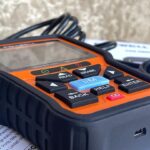The world of automotive diagnostics is constantly evolving, and OBDII scanners are essential tools for car enthusiasts and professionals alike. Back in 2017, discussions around OBDII scanners were vibrant, with users actively seeking reliable and feature-rich devices to understand and maintain their vehicles. Let’s revisit the key concerns and popular features from OBDII scanner reviews in 2017 and see what still holds true, and what has changed.
In 2017, much like today, the desire for user-friendly and comprehensive OBDII scanners was paramount. Discussions often revolved around the balance between affordability and functionality. Many users were moving away from basic code readers and seeking scanners that offered more than just engine fault codes. The ability to access systems beyond the Engine Control Module (ECM), such as Transmission, ABS (Anti-lock Braking System), and Airbag systems, was a significant point of interest. Reviews from 2017 highlighted the importance of broad vehicle coverage, ensuring compatibility with various makes and models.
Connectivity was another major aspect in 2017 OBDII scanner reviews. Bluetooth and Wi-Fi capabilities were becoming increasingly desirable, moving away from older, cable-dependent scanners. This wireless functionality offered greater convenience, allowing users to pair scanners with smartphones and tablets. Software interfaces were also under scrutiny. Users were looking for intuitive apps that could display diagnostic data clearly and offer real-time information. The ease of navigating the software, interpreting data, and generating reports was a crucial factor influencing user satisfaction.
Reliability and accuracy were non-negotiable in 2017, and remain so today. Reviews often pointed out the importance of a scanner providing accurate diagnostic trouble codes (DTCs) and reliable system readings. Furthermore, users valued scanners that offered helpful resources, such as databases of DTC definitions and potential remedies. The ability to export data for further analysis or sharing was also a sought-after feature.
While some discussions in 2017 touched upon budget-friendly scanners, there was a clear understanding that investing in a slightly more expensive, reputable brand often translated to better quality, broader functionality, and more reliable software. The “you get what you pay for” adage certainly applied to OBDII scanners then, as it largely does now. User reviews from that period often served as valuable resources to differentiate between scanners that offered genuine value and those that fell short on promises.
Looking back at OBDII scanner reviews from 2017 provides a valuable perspective. Many of the core needs and desires of users remain consistent. Reliability, comprehensive system access, user-friendly software, and convenient connectivity are still top priorities. While technology has advanced, and newer models offer enhanced features, understanding the discussions and concerns from 2017 can help today’s users make informed decisions when choosing an OBDII scanner. The fundamental aspects of a good OBDII scanner highlighted in 2017 reviews continue to be relevant benchmarks for evaluating current options.

